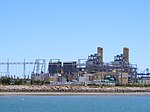St Kilda, South Australia

St Kilda is a coastal suburb in Adelaide, South Australia. Its seafront faces the Barker Inlet, which is part of the Port River estuarine area, the largest tidal estuary of Gulf St Vincent, and includes a large area of mangroves. St Kilda is an internationally recognised bird watching area with over 100 species of birds feeding in and around the mudflats, salt lagoons, mangroves and seagrass beds, which are part of the estuarine ecosystem. St Kilda has a small number of houses and a 2016 population of 70. There is a single connecting road from the suburb to the rest of Adelaide. The inhabited section of the suburb occupies less than 100 hectares (250 acres) along the seafront. The remainder of the land was formerly used for extensive salt evaporation ponds, although these are much fewer in number now. The settlement ponds of the Bolivar Waste Water Treatment Plant occupy some of the southern end of the suburb. St Kilda is bordered by Buckland Park to the north, Waterloo Corner to the east-north-east, Bolivar to the south and south-east, and Gulf St Vincent to the west. The suburb is home to a number of tourist attractions, including an adventure playground, tram museum, mangrove forest walk and an abundance of birdlife.
Excerpt from the Wikipedia article St Kilda, South Australia (License: CC BY-SA 3.0, Authors, Images).St Kilda, South Australia
Fooks Terrace, Adelaide
Geographical coordinates (GPS) Address Nearby Places Show on map
Geographical coordinates (GPS)
| Latitude | Longitude |
|---|---|
| N -34.738611111111 ° | E 138.53472222222 ° |
Address
Fooks Terrace
Fooks Terrace
5110 Adelaide
South Australia, Australia
Open on Google Maps





